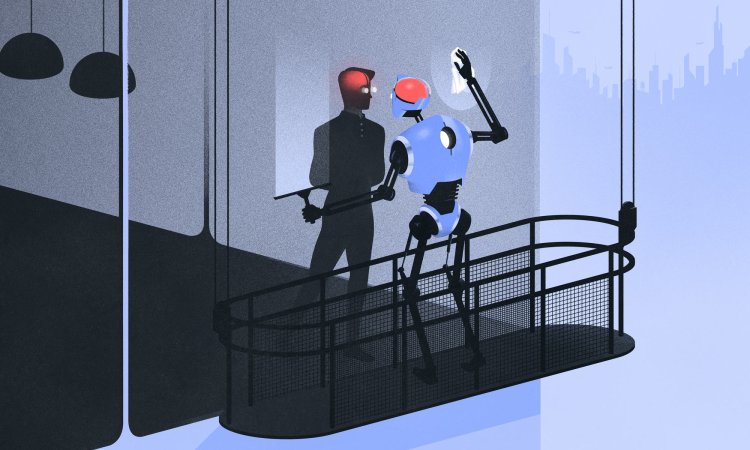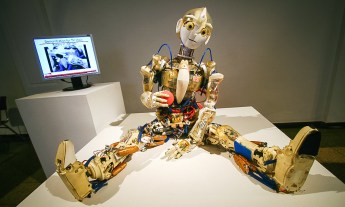
Economist Robin Hanson thinks the era of ems — robots with artificial copies of human brains — could occur in the next century. Read his astonishing predictions … and prepare for your jaw to drop.
The next big new-era-inducing change is likely to be the arrival of artificial intelligence, in the form of robots smart enough to substitute wholesale for human workers. I guess that the first such robots will be whole brain emulations or “ems.” An em results from taking a particular human brain, scanning it to record its particular cell features and connections, and then building a computer model that processes signals according to those same features and connections.
Such ems require three supporting technologies: brain scanners; brain cell models and signal-processing hardware (e.g., computers). Brain scans will be feasible when all three of these technologies are cheap and reliable. Recent developments suggest that these technologies are likely to be ready within at least a century, and perhaps within only a few decades. When it’s possible to scan a human brain at a fine enough spatial and chemical resolution, and to combine that scan with good enough models of how individual brain cells achieve their signal processing functions, we’ll be able to create a cell-by-cell dynamically executable model of the full brain in artificial hardware, a model whose signal input-output behavior is usefully close to that of the original brain.
Just as with the human from which an emulation was scanned, one could have conversations with an emulation. A functioning emulation would be capable of the same sorts of thoughts, attitudes, emotions, charisma and mental skills as the brain from which it was copied. It would also be capable of emulating similar experiences, such as the taste of cherry pie, the burn of exercise or the ecstasy of sex. The emulation would assume that it has consciousness and free will just as naturally as we do.
I further assume that the emulation can be cheaply combined with appropriate android or virtual reality bodies, and given sufficiently rich and familiar sensory inputs, these combinations of emulated brains and bodies can, after the usual job-training delays, effectively substitute for almost all ordinary human workers on almost all jobs. Also, this can be done at a cost well below the wages that most such jobs would have commanded had emulations not existed.
Humans are not the main inhabitants of the em era; they’ll live far from em cities, mostly enjoying a comfortable retirement.
The future era dominated by ems will happen mainly in a few hot, densely packed cities on Earth, where many billions (and perhaps trillions) of ems will be found. And just as foragers and subsistence farms were marginalized by our industrial world, humans are not the main inhabitants of the em era. Humans instead live far from the em cities, mostly enjoying a comfortable retirement on their em-economy investments.
Ems reproduce by making exact copies who remember exactly the same past and have exactly the same skills and personality, but who then diverge after they are copied and have differing experiences. Typically whole teams are copied together, work, and socialize together, and then retire together. All of the copy descendants of a single original human are together called a “clan.” Strong competitive pressures result in most ems being copies of the thousand humans best suited for em jobs. So ems are mostly very able, focused workaholics, at the level of Olympic medalists, billionaires or heads of state.
Most ems are made for a purpose, and they remember agreeing to that purpose beforehand. So ems feel more grateful than humans do to exist, and more accept their place in the world. Ems have less variety in wages and work productivity than we do, but more variety in wealth, size, speed, reliability and mental transparency. To most ems, it seems good to be an em.
To succeed in this new world, prepare to become what it needs.
So how can humans personally succeed in the era of ems?
Expect all of your abilities to earn wages as a human to quickly disappear after an em transition. Well before this happens, seek out substitute sources of income. Accumulate and diversify a financial portfolio of assets likely to retain value, such as stocks, real estate and intellectual property. Also accumulate and diversify a social portfolio of supports and connections. Both your financial and social assets should be tied to communities that are likely to thrive or at least survive in an em world. Try to be included in geographic regions, nations, professions, standards, etc., that are likely to cooperate with and add value to this new world, and avoid those that may pick fights with it.
Consider the possibility that you (or your children or grandchildren) might start one of the few most copied em clans, since successful clans will collect a big fraction of the gains. Realizing that the odds are greatly against you, you should be willing to take great risks to achieve this, by showing high and reliable productivity and flexibility in tasks and environments most like those of the em world.
If you or your associates (such as descendants) will be old at the time of the em transition, then try to have them be very productive and at the peak of their career ability. They should be good at tasks where a great many customers could be quickly served by ems doing that task; this would give you the best chance to be one of the very first highly copied ems. If you might be dead by the time of the em transition, you might consider becoming a cryonics customer, and then declaring your wish to be revived as an em when this becomes technically possible.
And if you or your associates will be young at the time of the em transition, try to plan their lives so they’ll be the ideal age (3 – 7 years old) for em scans during the early em era. Before that age, have them collect visible indications of their general ability to learn useful skills and do valuable tasks. They should also show that they get along with people much like themselves, and that they value life and can exhibit grit when it is hard and alien. Teach these virtues to your children and grandchildren. Such young people might then have a chance to become successful during the early em era, when a high value is placed on youthful flexibility. In sum, to succeed in this new world, prepare to become what it needs.
Excerpted with permission from the new book The Age of Em: Work, Love and Life When Robots Rule the Earth by Robin Hanson. © 2016 by OUP and published by Oxford University Press. All rights reserved.



















